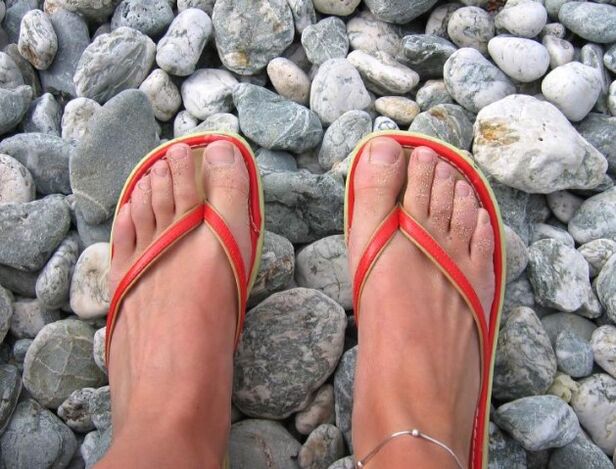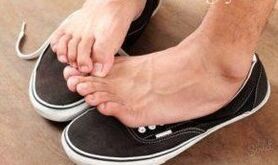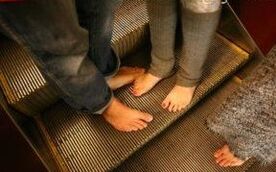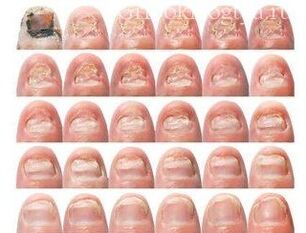Nail fungus is a rather dangerous phenomenon that can progress, destroying the entire nail plate. In the early stages of development, the fungus can be invisible to the eyes, however, its negative effect on the nail plate structure is intensified every day. How to identify yourself the fungus of nails and how to treat it, given the stage of the disease, we will analyze even more.

There are several signs that help determine the presence of fungal nail plate lesions:
- The nail loose - you can check when cutting the edge of the nail. If, in the process, the nails dwell, not cut, this is the first symptom of the presence of a fungus and a clear occasion to consult a doctor.
- The thickening of the nail plate, especially in edge hyperkeratosis (compaction), occurs due to the harmful effects of fungi that can disrupt nail fiber integrity, which is why the last change in qualitative and quantitative form.
- Excollation of nail and its cut under the skin - this phenomenon can cause not only to wear tight shoes, but also fungal lesions that modify the nail plate, providing the wrong place.
- Change in nail color (pale yellow to brown) - occurs as a result of the destruction of active components of the nail plate and the folding of protein cells during destruction.
- The presence of white plate - fungal spores penetrate deep into the root of the nail and also reaches the surface, which is dangerous for the extensive infection of all fingers.
The first signs that nail has lost its health and has problems caused by the active activity of mushrooms, are:
- Loss of shine and superficial shine;
- light yellowing of the nail;
- Extensive itching of the entire foot, the appearance of red spots full of transparent liquid;
- Unpleasant smell of legs, especially after abundant sweating;
- Crossing the skin in the jumps and soles, thick extensive.
These symptoms indicate various leg problems, so it is better not to neglect a doctor's consultation. Early diagnosis greatly facilitates the treatment process, ensuring a complete recovery.

Healthy legs in the legs: norm and deviation
To exclude or identify the presence of fungal diseases, you need to examine your own legs, fingers and nails. The following indicators must be kept:
- The foot of the legs is smooth, without grains, corns and seals.
- The skin of the legs is uniform, without cracks and blemishes.
- There is no redness and itching, especially between the fingers.
- The nail plate is flat, smooth, transparent.
- The nail bed, the surface with the shine is very visible.
If there are deviations from the declared standards, and the legs have an unpleasant pungent smell, medical appointment and research for the presence of the pathogen is needed.
Risk factors for the development of fungi in the legs
Fungi infection can occur anywhere, including household slippers. So that this happens enough to have:
- Weak immunity that is not able to restrict active mushroom reproduction;
- Increased leg perspiration due to inadequate and low quality quality shoes;
- the presence of cuts in the nail nail area or nail cut or cuticle;
- Insufficient foot hygiene as well as shoes;
- Frequent visit to public places where there is a high risk of infection: town baths, saunas, solarium, pool, local beach;
- Excessive use of cosmetics (varnishes, nail extension, refreshing sprays and leg gels), which leads to the death of local immunity.
Separate types of mushrooms have a different latent period during which the disease does not manifest itself.
You can be infected with a fungus in two ways:
- Contact - Through direct contact of a sick person to a healthy person: personal hygiene items, public places, wearing someone else's shoes.
- Contactly - Infection occurs due to the active development of mushrooms that are in each person's body. In certain situations (for example, a sharp decrease in immunity), its number increases and cannot be fully controlled by the body independently.
Most of the time, the people of the following categories are subject to fungal lesions:
- children with a thinner layer of skin;
- people suffering from HIV infection;
- With increasing foot sweating;
- The presence of chronic diseases that inhibit the immune system.

If there are the above indicators, it is necessary that the condition of nails on the legs and stop as a whole is carefully monitored, paying due attention to hygiene.
Differentiation of a disease from fungal nails
In medicine, the concept of "nail fungal damage" is collective, as mushrooms of various types can act as pathogen. Most of the time, these mushrooms are found on the nails of the legs as:
- Dermatophytes - A group of mushrooms that manifest themselves in the form of yellow spots or white vertical bands. The infected nail gradually loses its strength and shape, after which the cavity becomes lifeless and easily removes from the nail bed.
- Yeast injuries - arise as a result of the active activity of Candida's mushrooms. The nail itself is thinner and the perioline rollers coem and wave. It can manifest itself as an independent disease with frequent prolonged colds and weakened immunity.
- The molds - are located mainly on the surface of the nail, altering their color to a greenish, brown or whitish tone.
It is impossible to determine the causative agent of a fungal disease on his own, since the same fungi, when exposed to various aggregate factors, can manifest differently. Consequently, it is impossible to start treatment, as each type of mushrooms has their own antifungal medications that adversely affect the lives of pathogens. Therefore, by diagnosing the lowest deviations from the standard, you need to consult a doctor and take a test for the presence of a fungus.
Stages of fungal damage in the legs
The process from the moment of infection to the complete destruction of the nail plate is called stages of the disease course. Select -5:
- Infection - The fungus enters the surface of the nail, plunging into the cuticle on the nail bed.
- The incubation period (3 days to 5 months) - Mushroom activity is minimal, but intensifies with the speed of rays when all conditions are created for this: immunity is weakened, there is a moist warm medium, there is no proper hygiene. Externally, the period of incubation is not manifested at all.
- The early stage - the number of mushrooms is so great that it can have a negative effect on nail viability. The edges of the nail plate gradually become yellow from the edge to the nail bed. The nail acquires a matte tone, a healthy pink color disappears, the shine disappears from the surface. In this case, the dry skin of the fingers is observed.
- The active course stage - the mushroom population reaches the maximum, allowing you to infect other nail plates, having received disputes through contact. Hyperqueratosis is increased - increased keratin fiber production, under the influence of fungal activity. In this case, the nail is compacted, visibly prohibited above the surface of the finger.
- The last step - is determined by the murder of the nail plate as a result of the injury not only of the nail, but also of the nearby soft tissues. The entire surface of the nail has a yellow or brown tone, looseness is observed in the cut, which is accompanied by painful sensations.
With large -scale infection, local symptoms can also participate:
- dysbiosis in the form of feces disorder;
- Increased body temperature;
- leg pain, intensifying during movement;
- Confession connection.
All of the above manifestations help to determine the stage of onicomycosis exclusively. To identify the pathogen, you will have to do a special analysis indicating the exact genre and the type of fungi that caused onicomycosis.
How and what to treat

You need to understand that the key to successful treatment is a correct diagnosis, which is impossible to do at home at home. Only a doctor, based on the results of the analyzes, is able to identify a genre of mushrooms, and choose the appropriate treatment.
For many, it remains a mystery why, the antifungal drug bought in a pharmacy does not help. There are many reasons and explanations for this. First, initially the antifungal drug is selected based on the generator. Secondly, the treatment of the fungus is a complex event consisting of:
- Local therapy - Applying antifungal medications to the nail surface.
- Oral antifungal tablets that can suppress the development of fungi and reduce their number of inside.
- Immunestimulate medications that "force" the body to produce enough immune carts that independently fight the fungi.
- Compliance with the toe hygiene are washed 2-3 times a day, with cold soap and soap, after which they clean with a towel. The nail is cut every 3-5 days.
- Wearing shoes made of genuine leather, plus cotton linen.
Having excluded at least one of these 5 points, the recovery process will drag itself for many months or even become unsuccessful. Only comprehensive treatment will allow you to completely get rid of the fungus and exclude the risks of relapse manifestation.
Recipes for traditional medicine, which are so difficult to heal nail fungus, in most cases, are ineffective. The result will appear only when the above recommendations to combat fungal nail lesions will be added.
Thus, it is not difficult to determine the presence of a fungus on the nails of the legs. It is sufficient to perform an inspection of the nail plate and all fingers in general, comparing them with images indicating the presence of a fungus. Treatment is considered effective and correct only when performed under the control of experts. Self -duty can cause many negative health consequences, as well as complicate the additional treatment of the disease.
















